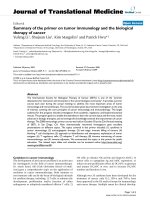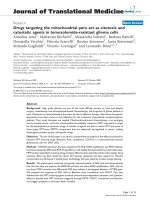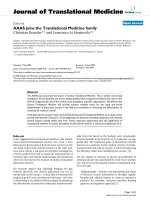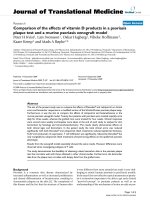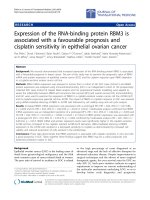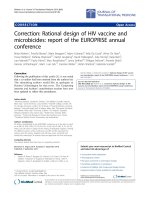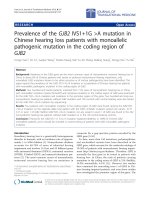Báo cáo hóa học: " Migratory birds, the H5N1 influenza virus and the scientific method" docx
Bạn đang xem bản rút gọn của tài liệu. Xem và tải ngay bản đầy đủ của tài liệu tại đây (185.57 KB, 3 trang )
BioMed Central
Page 1 of 3
(page number not for citation purposes)
Virology Journal
Open Access
Debate
Migratory birds, the H5N1 influenza virus and the scientific method
Thomas P Weber*
1
and Nikolaos I Stilianakis
1,2
Address:
1
Joint Research Centre, European Commission, T.P. 267, Via Enrico Fermi 2749, I-21027 Ispra, Italy and
2
University Erlangen-
Nuremberg, Department of Biometry and Epidemiology, Waldstr. 6, D-91054 Erlangen, Germany
Email: Thomas P Weber* - ; Nikolaos I Stilianakis -
* Corresponding author
Abstract
Background: The role of migratory birds and of poultry trade in the dispersal of highly pathogenic
H5N1 is still the topic of intense and controversial debate. In a recent contribution to this journal,
Flint argues that the strict application of the scientific method can help to resolve this issue.
Discussion: We argue that Flint's identification of the scientific method with null hypothesis
testing is misleading and counterproductive. There is far more to science than the testing of
hypotheses; not only the justification, bur also the discovery of hypotheses belong to science. We
also show why null hypothesis testing is weak and that Bayesian methods are a preferable approach
to statistical inference. Furthermore, we criticize the analogy put forward by Flint between
involuntary transport of poultry and long-distance migration.
Summary: To expect ultimate answers and unequivocal policy guidance from null hypothesis
testing puts unrealistic expectations on a flawed approach to statistical inference and on science in
general.
Background
We welcome the attempt by Flint [1] to base research on
the dispersal of H5N1 on a more secure scientific footing,
but we think that the approach suggested by him is seri-
ously flawed and counterproductive. According to Flint,
the scientific method is identical with null hypothesis test-
ing. However, this approach to statistical inference has
many weaknesses and is ill-suited for the task of identify-
ing the mechanisms that are responsible for a natural phe-
nomenon. Instead, we believe that Bayesian approaches
are far more productive. Furthermore, in his attempt to
show that arguments put forward by us [2] in the debate
about the means of dispersal of H5N1 are uninformative,
Flint also employs an analogy between poultry transport
and long-distance migration that is highly misleading.
Discussion
The myth of the scientific method and the trouble with
significance testing
Flint urges researchers to apply the scientific method
when collecting data and drawing conclusions concerning
the dispersal of highly pathogenic H5N1. The term "scien-
tific method", especially used together with the definite
article, suggests a unitary and well-defined process. We
think that Flint's ideas are far too strict and too normative
and probably even harmful. Flint takes a very narrow
approach that identifies the scientific method with the
formulation and testing of null hypotheses. This stance
can be countered on a historical and methodological
level: the scientific method is a historical and philosophi-
cal myth and null hypothesis testing is a very feeble and
inadequate method.
Published: 9 May 2008
Virology Journal 2008, 5:57 doi:10.1186/1743-422X-5-57
Received: 6 March 2008
Accepted: 9 May 2008
This article is available from: />© 2008 Weber and Stilianakis; licensee BioMed Central Ltd.
This is an Open Access article distributed under the terms of the Creative Commons Attribution License ( />),
which permits unrestricted use, distribution, and reproduction in any medium, provided the original work is properly cited.
Virology Journal 2008, 5:57 />Page 2 of 3
(page number not for citation purposes)
Flint appears to believe that only the testing of hypothe-
ses, not their discovery, constitutes science and is covered
by the scientific method. This is an outdated idea. The phi-
losopher Hans Reichenbach [3] introduced the notions of
"context of discovery" and "context of justification" into
the study of science. The former belonged to the domain
of historians, the latter to philosophers. Unfortunately,
this division kept philosophy of science away from nearly
everything that is fascinating about science: the challenge
and excitement of working towards discovering or pro-
ducing new phenomena in nature or in the laboratory.
Philosophy of science has fortunately moved away from
trying to impose narrow norms and methods on scientific
practice and today emphasizes the diversity of methods
and of the means of discovery and justification [4,5]. The
scientific method is what scientists do, not what philoso-
phers or scientists, who think that they are philosophers,
think they should do. Science is done by error-prone
humans working in complex institutions situated in a
messy world and therefore does not produce logically
indisputable proofs about natural phenomena – this hap-
pens only in trivial cases. It usually offers a robust consen-
sus based on a process of inquiry that builds on and
allows for constant scrutiny, re-examination, and revision
[6]. This is how science works. People ignore the fact that
all results in science, whether experimental or theoretical,
are provisional.
If we remain on the level of statistical inference, some of
these developments are reflected in the increasing use of
Bayesian methods in the life sciences. Null hypothesis sig-
nificance testing still is the dominant statistical approach
in biology. However, this approach has come under
attack, because it has many, increasingly acknowledged,
problems [7-9]. Significance tests provide information on
the probability of finding a specific or more extreme event
when the null hypothesis is true; they say nothing at all
about the probability of a null hypothesis being true.
Null-hypothesis-testing encourages rejection or accept-
ance of hypotheses, rather than an assessment of degrees
of likelihood. The p value in null hypothesis testing repre-
sents the probability of the data if the null hypothesis is
true. We believe that it is far more productive and interest-
ing to ask what the probability of a hypothesis is, given
the data. The latter requires a Bayesian approach. It also
encourages researchers to investigate more than two
polarized hypotheses. In such a context, our study [2] can
be seen as attempting to provide a basis for estimating
prior probabilities: How likely is the hypothesis that long-
distance migrants disperse H5N1 given existing data on
immunocompetence of migrants? It is not yet possible to
provide a quantitative and definitive answer to this ques-
tion, but this state of affairs should serve as a motivation
for more work.
To base research effort, allocation and policy decisions on
null-hypothesis testing and type I errors is unproductive.
Null hypotheses fail to capture the complexity of nature
by giving undue importance to just one of the hypothesis
with which the data may be consistent. There still may be
a place for significance testing, but it needs to be supple-
mented among other things by interpretative caution,
confidence intervals, effect sizes and power estimates.
The role of migratory birds and domestic poultry in the
dispersal of H5N1
It is beyond reasonable doubt that transport conditions of
poultry cause stress and can have a negative impact on
immunocompetence [10]. It is, however, very peculiar
and odd to compare involuntary transport of poultry with
long-distance migration of wild birds. We find it very hard
to make sense of this part of Flint's argument and our
reply is thus possibly off the mark. Perhaps Flint wants to
say that long-distance migration is such a central part of
the life-history of many bird species that they follow some
sort of "migratory program" and once they started to
migrate, they will not stop. The term "program" is in fact
often used in studies concerned with the hormonal and
neural control of migratory behavior, but migrants are not
automata that carry out their journeys irrespective of envi-
ronmental or physiological conditions. Modeling has
identified the selective forces (for example, strong season-
ality) that favor long-distance migration without having
to take recourse to obligatory internal, periodic processes
[11]. Such physiological processes do play an important
role in migration [12], but the existence of such mecha-
nisms does not imply necessity; these mechanisms have to
be seen as an outcome of selection for migration, not as a
cause of migration. It seems more reasonable to assume
that migrants base their decisions – when to depart for a
flight, the length of the flight episode, how much energy
to store etc. – on their own state (energy reserves, health),
the state of the environment (food supply, weather condi-
tions etc.) and the time of year. Health, or more generally
condition, is a state variable of central importance for our
argument.
Here is not the place to repeat the arguments put forward
in [2], but two findings need to be emphasized once
more. The results reported by van Gils et al. [13] and Has-
selquist et al. [14] suggest that some infected birds may
migrate with a reduced speed or refuse to embark on long
flights. There are many open questions; especially the
findings reported in [14] imply that the interaction of
infection and heavy physical work in migratory birds may
not lead to a clear cut pattern: birds in good general phys-
ical condition may be able to deal both with an infection
and long flights, whereas birds in bad condition may not.
We nowhere claim that it is completely out of the ques-
tion that wild migratory birds contribute to the spread of
Publish with BioMed Central and every
scientist can read your work free of charge
"BioMed Central will be the most significant development for
disseminating the results of biomedical research in our lifetime."
Sir Paul Nurse, Cancer Research UK
Your research papers will be:
available free of charge to the entire biomedical community
peer reviewed and published immediately upon acceptance
cited in PubMed and archived on PubMed Central
yours — you keep the copyright
Submit your manuscript here:
/>BioMedcentral
Virology Journal 2008, 5:57 />Page 3 of 3
(page number not for citation purposes)
H5N1. The interesting question is to what extent and over
which distances wild birds can contribute to this spread.
Conclusion
Thinking only in terms of accepting or rejecting polarized
null hypotheses obstructs debate and research about key
questions concerning the spread of H5N1. This method
only delivers the appearance of certainty. Following Flint's
proposals also entails more serious ethical dilemmas than
he suggests. Incorrectly concluding that migratory birds
can disperse the virus is not just inefficient. Such a conclu-
sion could be used to support measures that impose high
costs on migratory birds – a group of organisms that in
any case already suffers severely from environmental deg-
radation and climate change. Policy decisions that affect
human health, important economic activities and the
existence of threatened species deserve a better founda-
tion than the "scientific" method identified by Flint.
Competing interests
The authors declare that they have no competing interests.
References
1. Flint PL: Applying the scientific method when assessing the
influence of migratory birds on the dispersal of H5N1. Virol J
2007, 4:132.
2. Weber TP, Stilianakis NI: Ecologic immunology of avian influ-
enza (H5N1) in migratory birds. Emerg Infect Dis 2007,
13:1139-43.
3. Reichenbach H: Experience and Prediction Chicago: The University of
Chicago Press; 1938.
4. Hacking I: Representing and Intervening Cambridge: Cambridge Univer-
sity Press; 1983.
5. Galison P, Stump DJ, (eds): The Disunity of Science Stanford: Stanford
University Press; 1996.
6. Oreskes N: Science and public policy: what's proof got to do
with it? Environ Sci Policy 2004, 7:369-383.
7. Harlow LL, Mulaik SA, Steiger JH: What If There Were No Significance
Tests? Mahaw, NJ: Erlbaum; 1997.
8. Kline RB: Beyond Significance Testing Washington, DC: American Psy-
chological Association; 2004.
9. Nickerson RS: Null hypothesis significance testing: a review of
an old and continuing controversy. Psych Methods 2000,
5:241-301.
10. Mulder RWAW: Impact of transport and related stresses on
the incidence and extent of human pathogens in pigmeat
and poultry. J Food Safety 1995, 15:239-246.
11. Barta Z, McNamara JM, Houston AI, Weber TP, Hedenström A, Feró
O: Optimal moult strategies in migratory birds. Phil Trans R
Soc B 2008, 363:211-229.
12. Berthold P: Control of Bird Migration London: Chapman & Hall; 1996.
13. van Gils JA, Munster VJ, Radersma R, Liefhebber D, Fouchier RAM,
Klaassen M: Hampered foraging and migratory performance
in swans infected with low-pathogenic influenza A virus. PLoS
One 2007, 1:e184.
14. Hasselquist D, Lindström Å, Jenni-Eiermann S, Koolhaas A, Piersma T:
Long flights do not influence immune responses of a long-dis-
tance migrant bird: a wind-tunnel experiment. J Exp Biol 2007,
210:1123-1131.
